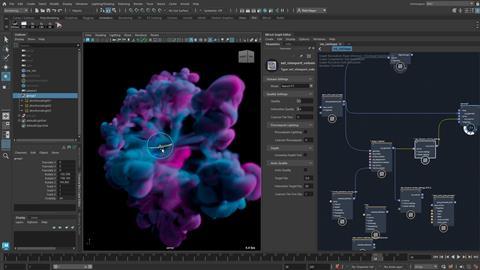Company is working with Microsoft on Maya Assist, which is now in private beta

Autodesk has revealed a host of updates for its media and entertainment proucts, among them a private beta version of an AI assist tool for Maya developed with Microsoft.
Called Maya Assist, it provides a new way of interacting with Maya scene data using Microsoft’s Azure OpenAI Service. The product allows artists to automatically manipulate scenes using natural language text prompts directly in Maya. For example, you can ask to copy an object, increase its size by 25%, or add a camera and aim it anywhere. The private beta launches on 5 April, and applications are here.
In addition, Autodesk has a host of other updates for Maya, as well as 3ds Max, Bifrost, and Arnold, further open standards and bolster artist-driven animation, modeling, and simulation workflows.
This includes LookDevX, a new agnostic material editor in Maya, standardizes material workflows, allowing artists to create complex shading networks that can be shared freely and accurately throughout studio pipelines. With a modern, node-based environment, this enables artists to author a variety of materials like USDShade, Material X, and Arnold that can then be used by other artists across multiple projects.
For 3ds Max, there is a new Boolean modifier that allows the production of clean geometry, and updates to the Array modifier help create beautiful, nature-like scenes, procedurally.
For Maya, there are redesigned animation tools, and updates to Retopologize and the Boolean toolset. Bifrost, Maya’s visual programming environment, has had a complete overhaul of viewport volume rendering, using NanoVTT technology, as well as MPM Gel, a new capability that simulates substances such as soft-serve ice cream.
Moreover, Maya–including Bifrost and Arnold for Maya–now runs natively on Apple Silicon.
Finally, Autodesk is partnering with Adobe to bring Autodesk Standard Surface and Adobe Standard Material into one new material model that can be used across product portfolios and adopted by the wider industry. The pair are engaging with the MaterialX governance group to ensure that the new model can be integrated and fully encoded within a MaterialX node graph.
Diana Colella, senior vice president of Autodesk Media & Entertainment, said: “Whether they’re working on the next big blockbuster, streaming content, or games, our customers use a lot of different tools to get productions out the door. It’s a top priority for us at Autodesk to help connect their workflows, so they can work nimbly and efficiently across teams and projects.
“That’s why we’ve focused our development efforts on integrating open standards like USD, LookDevX, and OCIO across our tools. We’re excited to continue on this path, building deeper connections between our solutions and third party tools, so that our customers have truly connected workflows for collaboration.”
































No comments yet